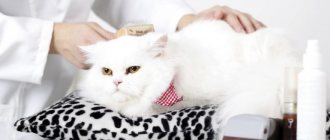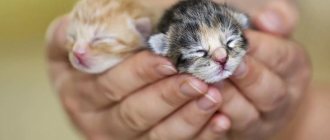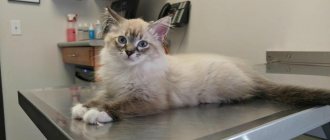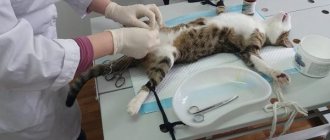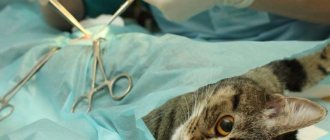Castration is a surgical intervention performed on cats to remove the gonads. The procedure cannot be called mandatory for all pets, but with its help it is possible to eliminate certain behavioral characteristics of the male that appear after the onset of puberty. However, the reason for castration is not always the behavior of the male; sometimes there are medical indications for this. If an animal is injured, has some kind of congenital pathology or some other indication, then castration becomes a mandatory procedure, which is prescribed by a veterinarian when diagnosing the disease. However, most often, pet owners independently express a desire to castrate their cat, since there are no plans for its further reproduction.
There are many myths about the dangers of castration, but most of them are easily refuted by experts. However, as with the need for any other operation, castration has its advantages and disadvantages. If you seek the services of an experienced veterinarian, you can prevent almost any complications.
Is it necessary to neuter a domestic cat?
Suitable age to sterilize a cat
Is castration harmful?
Myths about the dangers of castration
How to care for a cat after surgery
Methods, methods of castration
In modern veterinary medicine, there are various castration techniques. The types of castration methods are divided according to the degree of intervention. The most common of them are open and closed methods. In addition, there are techniques in which parts of the pet’s genital organs are not removed.
- Surgical methods
of intervention:
- Bloody. Classic manipulations - open, closed. The open method is the main one. In this way, the testes are removed using scissors. The closed method involves cutting only the skin.
- Bloodless. This method involves castration by destroying the vas deferens, the epididymis or the entire testis. Vasectomy is a sparing method. During the procedure, the pet's blood vessels and nerves are not affected; the vas deferens are partially destroyed.
- Castration by irradiation.
The cat's sexual activity is reduced due to the effect of radiation on the testes and appendages. Although this method is non-surgical, it can cause the development of cancer in the animal. - Chemical castration.
The pet is either given a special injection or given pills that suppress sexual desire. - Chemical castration on implants.
The technique is expensive, but allows you to restore reproductive capacity in the future. The implant is injected into the cat’s skin, which reduces sexual desire after 6 weeks for a long time. - Castration-microwave
. Irradiation with microwave rays guarantees the result forever; anesthesia is a necessary condition for this procedure. The method has been proven in agriculture, but has not gained popularity in veterinary medicine. The procedure requires a microwave emitter, and the consequences have been little studied.
Traditional methods of surgical castration of cats remain popular in veterinary clinics.
General information
So what is castration? Many (even among veterinarians) believe that this term refers to the surgical removal of the testes (testes). But in reality this is far from the case. Yes, in most cases classical surgical castration is indeed practiced, but still this is far from the only option. There are ways to stop an animal’s sexual activity without surgical removal of organs.
For now, we will consider the arguments for castration, even of an adult animal:
- The pet becomes calmer (however, this does not apply to cases where the cat was overly aggressive before castration).
- The likelihood of cancer of the reproductive system organs is sharply reduced. Of course, with castration at an early age, this rule works much better, but still the chances of cancer are reduced in this case.
- In some cases (chronic orchitis, cystitis, etc.) castration is the only way to keep the cat healthy in the future.
- The animal will no longer run away from home. In veterinary practice, there are cases when breeders began to castrate all their cats after they lost their pets who ran away “on a party” and got hit by a car (or were killed by falling from a balcony).
Recommended castration age
Kittens can be sterilized from two months of age; the risk of complications and bleeding is low. Two- or three-year-old cats can only be sterilized under general anesthesia, since local anesthesia can be ineffective. The optimal age for defermenting a pet is from six to twelve months, but not later than seven years. During this period, sex hormones do not have a significant effect on the development of the cat’s body, while the condition of the genital organs is ideal for performing the procedure.
Local anesthesia is required in this age category, rehabilitation is quick. Also, the time that is considered ideal for performing surgical procedures is determined according to the breed, physiological state of the pet, and individual characteristics. British and Persians, for example, are considered high-risk breeds. It is best to neuter them between 8 months and a year.
The age category is not a limitation if the cat suffers from any ailments or if the owners have not decided on surgery for a long time and the animal is more than seven years old. The operation can be performed, but, in any case, the veterinarian will conduct an examination and, if necessary, prescribe tests.
Should an outdoor cat be neutered?
To take control of the reproduction of stray animals, animal rights activists and concerned people catch cats, sterilize them and release them back. But why castrate cats living on the street if a sterilized female cannot produce offspring from them? There is a myth that castrated males after surgery will not survive in street conditions because they will become more cowardly, indecisive, and will be killed by alpha males. But the operation does not in any way affect the character of the animal, but only reduces aggression in especially active individuals.
Here are just a few arguments for castration of stray cats:
- the craving for females disappears, which means that the operated animal is excluded from the number of competitors: other males will not fight with it;
- the cessation of the production of sex hormones makes the animal more careful; it will not get into an unpleasant situation again, for example, it will not cross a busy highway in search of a female;
- if a stray cat is fed by guardians, after castration he will remain close to the feeding place and will not look for adventures outside his territory;
- stray cats are not all sterilized yet, this means that a cat can give birth to at least 32-48 kittens in a year, which will join the ranks of the homeless.
Why is this needed? Pros. Cons and contraindications
Sterilization of felines is resorted to in order to stop or suspend reproductive function. The production of male hormones stops and, as a result:
- the cat stops screaming at night;
- aggressive behavior is replaced by affectionate behavior;
- The problem of territory marks and unpleasant smell in the apartment is solved.
- Veterinarians note other positive aspects of surgical intervention:
- the life expectancy of a neutered furry friend is 1.5-2 years longer;
- the search for the cat ends;
- exclusion of diseases such as adenoma, prostatitis, breast and anal gland tumors;
- the pet becomes balanced, obedient, and does not get into fights.
Among the disadvantages are laziness and a sedentary lifestyle, which results in obesity and related problems. Urolithiasis is also possible. To avoid these manifestations, you should adjust your diet. Anesthesia also carries some risk, especially for older cats. In addition, surgery may be accompanied by complications. It is important that the procedure is carried out by an experienced, qualified and responsible doctor.
Surgical manipulations for the purpose of defertility are prescribed only to healthy males. In veterinary medicine, the following contraindications are identified:
- liver, kidney failure;
- cardiovascular diseases;
- anemia;
- epilepsy;
- respiratory diseases, including bronchial asthma;
- exhaustion of the body;
- time before scheduled vaccination 14 days;
- 30 days have not passed from the date of the last vaccination.
In order to minimize risks, veterinarians do not recommend castrating cats younger than 7 months and older than 8 years.
Preparing the animal for surgery
Owners of a cat who is going to be neutered should remember some rules:
- the pet must be healthy, without external signs of disease;
- before the operation, the furry friend must be examined by a specialist and prescribed general and biochemical blood and urine tests;
- It is also advisable to undergo an examination by a cardiologist: it is necessary to exclude the possibility of pathologies of the heart muscle and heart diseases;
- ten hours before the procedure you cannot feed or drink the cat.
For sterilization, you will need a veterinary passport, a device for transporting a furry friend (preferably with a convertible top), a warm blanket, a disposable diaper as bedding, and napkins.
The veterinary clinic will require proof of vaccinations and deworming. In some cases, it is allowed to defertilize an unvaccinated animal using a special medicine. The presence of vaccination reduces the risk of developing dangerous infectious diseases, as it develops immunity.
Treatment against worms before castration is carried out unscheduled ten days before the procedure.
Anesthesia
The operation is performed under general anesthesia. Veterinary clinics use the inhalation method, intramuscular and intravenous injections, and gas anesthesia for anesthesia.
The latter has no side effects, does not cause pain and does not have any side effects on the body. In addition, the supply of gas anesthesia is controlled during the period of manipulation: the concentration of the drug can simply be reduced or increased. With this type of anesthesia, your pet can be quickly brought out of this state.
The drugs used for anesthesia are determined by the doctor depending on the general health of the animal and other indicators. Under anesthesia, the cat sleeps, does not perceive pain, his consciousness is turned off and his muscles are relaxed. The selection of drugs is carried out individually in veterinary clinics. Intravenous anesthesia is considered the most effective.
The substance acts quickly and has no side effects on the heart and lungs. The intramuscular method has an affordable price and is considered traditional. Inhalation, in comparison with other methods, is more complex and expensive, and is rarely used.
Procedure in stages
The operation algorithm is as follows:
- Disinfection of the operated area.
- Anesthesia. The animal is restrained and immobilized. Sedatives may be prescribed several days before the procedure. Before administering an anesthetic, veterinarians mainly carry out pre-medication prophylaxis with a special drug that prevents side effects.
- Excision of testes. A qualified specialist uses disposable instruments to remove the genitals in the traditional open manner. The male's scrotum is pulled back and each layer is cut. After exposing the testis, the spermatic cord is ligated and cut 5 mm lower. The wound surface is treated with an antiseptic. Mostly, several seams are repaired or there is no need for it at all. Elderly males are sterilized using the closed method:
- scrotal incision;
- twisting of the vaginal membrane;
- thread stitching;
- establishing a ligature;
- cutoff;
- cauterization with tincture of iodine.
Recovery from anesthesia and recovery after the intervention occurs within two to three days. The cat will feel nauseous, its movements will be uncoordinated, and the animal will need increased care.
Caring for an animal after castration. Possible complications
The patient must stay in the veterinary clinic for the first hours. During this period, the doctor will be able to make sure that the cat tolerated the anesthesia normally. In the first postoperative hours, the following manifestations will be observed in your pet:
- dizziness;
- nausea;
- feeling of thirst;
- muscle weakness;
- dry eyes;
- low body temperature;
- unsteadiness of gait.
The pet can remain under the supervision of a veterinarian for the first 24 hours, but this will put him in a stressful state. Experienced doctors recommend taking the cat home. The pet needs attention and care, as well as painkillers. The groin area should be examined daily. To speed up the healing of the stitches, they are treated with peroxide and brilliant green.
To prevent the animal from licking the wound, you can wear a special collar that is removed when eating. Tetracycline ointment should be used for eye care. A warm heating pad will calm your furry friend and give him a feeling of comfort. Recovery after surgical procedures is easier in winter. In summer, you also need to take antibiotics.
At first, the cat's toilet should be bright so that the owner can notice the bleeding. You can wear a diaper with a hole for a tail. The first time after sterilization, animals experience a decreased appetite, then an increased one. You should give your cat enough water and monitor its diet. Your pet should not overeat.
Complications after surgery cannot be ruled out. The consequences of surgical manipulations are divided into:
- Early. Bleeding, prolapse of the spermatic cord, omentum, etc. are noted immediately.
- Late. Inflammatory and infectious pathologies develop gradually.
- Scrotal swelling and inflammation are often caused by poor sanitary and hygienic conditions. The most dangerous phenomenon is a retroperitoneal abscess. This is a secondary type of complication that occurs due to inflammation of the spermatic cord.
To avoid pathological processes, preference should be given to a proven and professional clinic.
Postoperative period
To quickly restore the cat and prevent complications, it is necessary to follow all the specialist’s recommendations in the two-week period after the intervention. Features of care on the first day depend on how long the anesthesia wears off after castration of the cat. Animals that require castration under general anesthesia require the most attention.
Post-operative care
Upon returning from the clinic, the cat should be placed on a bedding and covered, since as a result of the administration of painkillers, natural thermoregulation is disrupted. Every 20-30 minutes it must be turned over on one side or the other, which will make it possible to prevent numbness and muscle spasms. As cats recover from anesthesia, they may experience unsteadiness on their paws, a staggering gait, and blurred vision. After castration, a cat may behave somewhat strangely: hide, not make contact, or be restless and overly active. During the first few days after castration, this behavior is within normal limits.
If the cat starts to get up, you need to place a tray nearby so that he doesn’t have to go far. Sometimes 1-2 times after surgery, a disoriented animal may wander past the tray or diaper. In this case, you should not scold the cat, since these are just consequences of the operation.
If your cat licks stitches too often or suffers from oral diseases, a special collar may be required in the postoperative period. It will prevent infection and suture dehiscence. How long to wear a collar? The timing is determined by the veterinarian depending on how long the wound takes to heal. It is recommended to bathe the animal no earlier than 2 months after the procedure. If necessary, contaminated areas can be wiped with a damp, well-wrung out sponge.
Proper care in the first days is very important, since the successful outcome of the procedure largely depends on it.
How long does it take to recover from anesthesia?
To correctly assess your pet’s condition, you should know how long it takes for cats to recover from anesthesia. It all depends on the method of pain relief, the characteristics of the body, the drug and the correct calculation of the administered dose.
So, how long does it take for a cat to recover from anesthesia after castration? Sleep usually lasts from 30-40 minutes to 4-5 hours. If a castrated cat does not come to his senses for a long time, you should periodically check his reactions: touch his nose, paws, ears. The cat's attempts to pull his paw or move his ear indicate that there is no reason to worry.
Feeding
Caring for a cat after castration includes a certain drinking and feeding regimen. As soon as the animal wakes up, it needs to moisten its larynx. To do this, a small amount of liquid is poured into the cat’s mouth in small portions, since the swallowing reflex is not restored immediately. A bowl of water is placed when the cat has completely recovered from the effects of the drugs.
Feeding a cat is carried out only if the animal itself shows interest in food. You shouldn't do this by force. Portions should be small, and the volume of food the cat should be increased gradually.
What to feed
What to feed a cat after castration? In the first days, it is worth giving light food: meat or fish puree, dry food pre-soaked in water.
After how long
How long after castration can you feed a cat? Typically, 7-8 hours are enough to recover from anesthesia. You can give food to your cat no earlier than this period.
Complications
All possible complications of castration are divided into those that occur immediately after the procedure and later ones that appear during the healing process. In the first hours after the cat has undergone surgery, it is necessary to monitor its condition. If swelling, wheezing, or a sudden change in temperature or color of the mucous membranes occurs, you should immediately seek medical help. A cat’s poor reaction to anesthesia can result in death if not intervened in a timely manner.
The most common postoperative complications in cats include swelling and hematomas. In such cases, the animal does not go to the toilet for a long time, licks the enlarged scrotum, and shows anxiety. As a rule, blood or lymph that has accumulated in and around the scrotum dissolves on its own after some time.
Castration can cause more dangerous complications in cats: infection of the sutures (accompanied by fever and purulent discharge), damage to the urethra (the cat's urine will contain blood), bleeding and hemorrhages. In order for castration to take place without complications, it is necessary to properly care for your pet and trust it only to a proven, qualified specialist.
How long does it take for a wound to heal after castration? With standard castration, a period of 7 to 10 days is considered the norm.
Animal behavior after the procedure
Spaying is difficult for your pet to tolerate. The behavior of a castrated cat is characterized by the following manifestations:
Anxiety in the first 5-6 hours. The animal meows after the anesthesia wears off and is tormented by headaches. Attention and affection from the owner will help make it easier to survive the post-operative period.
After this period of time, the cat will sleep a lot. Thus, the pet regains its strength.
After a few days, the cat may be shocked by the absence of genitals. To distract your pet, you need to play with it more often, talk and pet it.
If changes appear that are of great concern to you, contact the veterinarian who performed the operation. Assessing the normal level of behavior is possible only after a qualified examination.
What is the price
Russia
- Moscow and St. Petersburg – 1000 – 3000 rubles;
- Regions of Russia – 850 – 2500 rub.
Ukraine
- Kyiv – 350 – 900 hryvnia;
- Regions of Ukraine – 250 – 500 UAH;
Be careful when choosing a clinic. If a small and attractive price is indicated, it is quite possible that this is a marketing ploy with which they are trying to lure you.
A suspiciously low price for castration indicates that you may be additionally billed for anesthesia, medications and consumables. Take the time to find out everything in detail before you sign up for the operation.
Castration for diseases
There are medical indications for which castration is vital:
- prostate cancer, other neoplasms in the genital organs;
- testicular injuries;
- urolithiasis disease;
- genetic pathologies.
Among the genetic diseases is cryptorchidism. With this disease, one or both testicles remain in the groin under the skin or in the peritoneum. In a healthy animal, the ovaries extend into the scrotum. In this case, surgery is indicated. If the procedure is not carried out, the development of testicular pathologies may occur, including saminoma - an ovarian tumor. This operation is more difficult and expensive.
How does the intervention work?
Many owners worry that the cat experiences pain and discomfort during the procedure. In fact, the only unpleasant moment is the injection of an anesthetic drug. Regardless of how cats are castrated (under general or local anesthesia), they do not feel pain.
As soon as the anesthesia takes effect, the doctor proceeds directly to the manipulation. How this happens depends on the type of procedure chosen. Typically, the testes are removed through two small incisions in the scrotum, after ligating the spermatic cords. At the end of the procedure, the veterinarian will give detailed instructions on how to care for the cat after castration.
Advice from experts and owners
According to the advice of veterinarians, castrating a male is safe, quick and with virtually no consequences. Modern clinics offer excellent conditions for the procedure. The operation takes place within 10-15 minutes, complications are rare.
If this procedure is not carried out, the cat will mark the territory, thereby damaging the owners’ personal belongings and furniture. The way out of the situation is to send the cat for a walk outside and find the cat yourself or bring the pair home. In this case, there is a risk of a fight, as well as other negative consequences.
Owners of mustachioed pets who have undergone castration are advised to resort to the procedure. If the animal is a pet and practically never goes outside, there is no point in torturing it.
